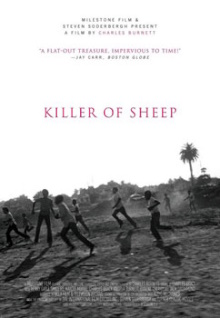This feels more like a documentary or even an ethnographic study in video form than a film. Indeed this made was by director Charles Burnett as his masters’ thesis. It features music from some big names and since it never secured the rights to them until 2007, it wasn’t even legal to release this. It seems that many people still managed to watch this and in the intervening time, its reputation has grown until it is now considered one of the greatest films of all time. I’d say that this is certainly something special and the music it uses is absolutely essential to its identity. This is another one of those films that aim only to capture a specific place, time and people and it does nothing short of bringing them to life before your eyes.
This film consists of episodic scenes from the lives of Stan and his family who live in Watts, Los Angeles. There’s little connective tissue between the scenes and no real plot. He works in a slaughterhouse and the regular hours provide enough income to let his family get by but little more than that. His wife is worried that he seems unhappy all the time and is no longer sexually interested in her. His children spend their days playing unsupervised with the other neighborhood kids, often doing dangerous things like pelting each other with gravel or jumping between rooftops. What little spare money he has is soon wasted on pointless endeavors. At one point, his friend Bracy wants to fix up a car and Stan helps him buy a replacement car engine to do so. However when they carrying the engine to Stan’s truck, Bracy carelessly leaves it unsecured so it simply falls off the truck and becomes useless. Interspersed throughout is the music of black artists, forming a soundtrack to their lives.
This makes for a startling portrait of abject poverty even as Stan himself vehemently rejects any suggestion that he is actually poor. He and his family have a roof over their heads and they’re not starving. Yet it seems impossible for them to live any better than this and Stan seems to have little control over his fate. Some acquaintances come by to offer him a chance to make some money through criminal activities and though he turns them away, it shows that in this kind of neighborhood, crime is one of the few ways that someone can rise above this sort of existence. Most depressing of all, this film captures a kind of fatalism in their worldview. The minor injuries the kids sustain while playing are shrugged off. When the engine is destroyed, Bracy throws his hands up into the air as if to say: what more can one do? The monotonous nature of Stan’s work at the slaughterhouse emphasizes the emptiness of their lives with seemingly nothing to look forward to.
This is a truly remarkable film and I rather doubt it could be made today. So much of it can be interpreted as portraying black people in a negative light, with it showing how rife crime is in their neighborhood for example or showing them lazing around doing nothing in particular. I think it’s a brutally honest portrait of a poor neighborhood and demonstrates how impossible it is for someone in that milieu to grow out of it no matter how well-intentioned they might be or how hard they work. The music is essential to the experience as their lyrics and themes directly speak for the characters in scenes when there is no dialogue. Interestingly, Burnett stated that he intended to make a history of African-American music in the first place.
So this is indeed a once lost and since then restored classic that lives up to its now towering reputation. I will note that Burnett made other films after this but none of them seem to have made as much of an impact. It’s a great example of an art film that hits the audience at their core, yet requires no special interpretation or deep references to understand. Highly recommended.
